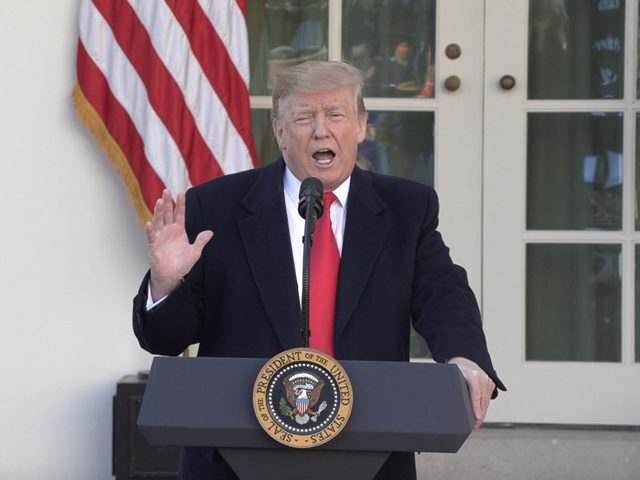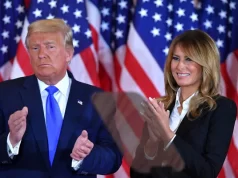President Donald Trump on Friday demanded that U.S. companies stop doing business with China and announced he would raise the rate of tariffs on Beijing, capping one of the most extraordinary days in the long-running U.S.-China trade war.
By the end of the trading day, the Dow Jones industrial average had fallen 623 points, or 2.3 percent; the business community had ratcheted up criticisms of the president; and world leaders descending on the Group of Seven summit in France were confronted with the prospect of a global slowdown, triggered by a trade war with no end in sight.The combination of events nearly eclipsed a twitter tirade in which Trump questioned whether Federal Reserve Chair Jerome Powell was an “enemy” of the United States.
The dizzying series of events Friday pushed the trade war between the world’s economic superpowers into a dangerous new phase. Several developed nations appear to be slipping into recession, and many governments and companies had hoped that recent signs of economic weakness in China and the United States would push the parties to the bargaining table.
Friday began with Beijing’s announcement that it would impose new tariffs on $75 billion in goods, including reinstated levies on auto products, starting this fall. By the afternoon, Trump tweeted that he would raise the rate of existing and planned tariffs on China by 5 percentage points. Beijing’s tariff retaliation was delivered with strategic timing, hours before an important address by Powell, and as Trump prepared to depart for the G-7 meeting in Biarritz.Trump initially directed his ire at Powell in Friday tweets, painting the Fed’s lack of monetary easing as a greater threat to American workers and businesses. “My only question is, who is our bigger enemy, Jay Powell or Chairman Xi?” he tweeted.
Moments later, he demanded American companies cut ties with China.”Our great American companies are hereby ordered to immediately start looking for an alternative to China, including bringing your companies HOME and making your products in the USA,” Trump tweeted.
The White House does not have the authority to force companies to follow such directives, and Trump’s demand came under sharp and immediate criticism from the U.S. business community, which warned that halting sales with such a large trading partner would hurt American companies and the broader economy.
“Trump may be frustrated with China, but the answer isn’t for U.S. companies to ignore a market with 1.4 billion consumers,” Myron Brilliant, executive vice president of the U.S. Chamber of Commerce, said in a statement. “Escalating tensions is not good for market stability, investor confidence or American jobs.”U.S. stocks declined, although not as dramatically as at other points in the year. The S&P 500-stock index fell 2.6 percent, while the Nasdaq Composite sagged by 3 percent, nowhere near some of the worst drops of the year.
But the promise of future dangers remained. Late Friday afternoon, Trump tweeted that he would be raising the tariff rates on some $250 billion in Chinese goods from 25 percent to 30 percent. The president also tweeted that he would increase the rate on an additional $300 billion of Chinese goods that have yet to go under tariff from 10 percent to 15 percent.
Business interests have been cautious not to denigrate Trump’s trade moves with China too strongly, eager to support the president’s goals of fairer trade practices and maintain a bridge to the administration. But Trump’s stunning directive for U.S. companies to sever ties to China represents a new threat for U.S. multinational corporations that have spent years cultivating the growing Chinese consumer market.
“I have no idea how the president thinks he can order companies to stop working with China. I’m baffled,” said Brian Riedl, a budget expert at the Manhattan Institute, a conservative think tank.Conservative groups were taken aback by the president’s order for companies to cut ties to China, saying they did not expect such a significant escalation from the president.
“The instruction for U.S. firms to leave China was quite stunning. I’m completely surprised by it,” said Alison Acosta Winters, senior policy fellow at Americans for Prosperity, a conservative group. She said there was “tremendous concern” among lawmakers, including congressional Republicans, about the direction of the trade war, which has hogtied the world’s two most powerful economic engines for more than a year.
Beijing’s new import taxes range from 5 to 10 percent and take effect Sept. 1 and Dec. 15 – the same dates Trump’s latest tariffs on $300 billion in Chinese goods are slated to kick in – the Chinese Finance Ministry announced. China’s 25 percent tariff on automobiles and 5 percent levy on auto parts go into effect Dec. 15.
The showdown between the United States and China is affecting the global economy, Powell acknowledged in highly anticipated remarks earlier Friday.”The global growth outlook has been deteriorating since the middle of last year. Trade policy uncertainty seems to be playing a role in the global slowdown and in weak manufacturing and capital spending in the United States,” he said.
Powell offered little by way of concrete assurance, saying the Fed would “act as appropriate to sustain the expansion” – a phrase he returns to frequently – and cautioned that there are “no recent precedents” to guide policy response to the trade war.
“While monetary policy is a powerful tool that works to support consumer spending, business investment and public confidence, it cannot provide a settled rule book for international trade,” Powell said.The conflict has taken a toll around the world. China’s economic growth has slowed to its lowest rate in 27 years, as factory output declines and unemployment rises. Central bank leaders in Europe, Asia and Australia have cut interest rates in recent weeks, citing the need for economic stimulus.
Domestically, the manufacturing sector contracted for the first time in a decade. Sales of U.S. exports have decreased at the fastest pace since August 2009. When exports fall, manufacturers typically react by reducing inventories and cutting production, which can lead to job cuts.
While American consumers, whose spending fuels about 70 percent of the U.S. economy, have largely been shielded from the trade war’s carnage, that is poised to change. Earlier this week, JPMorgan Chase estimated that American families will absorb an additional $1,000 in annual costs from all Chinese tariffs after the 10 percent levies take hold. If the upcoming tariffs are raised to 25 percent, as Trump has warned, that cost jumps to $1,500, researchers estimated.
And last week, for the first time since the run-up to the Great Recession, the yields – or returns – on short-term U.S. bonds eclipsed those of long-term bonds. This phenomenon, which suggests investor faith in the economy is faltering, has preceded every recession in the past 50 years.Despite signs of a homegrown slowdown, Trump – at least publicly – maintains that the United States is immune to the weakening economic trends rattling other countries.
But even as he has touted the strength of the U.S. economy, Trump has repeatedly attacked Powell for not providing enough stimulus through rate cuts, even though the central bank cut rates in July for the first time since the financial crisis.”The trade war is taking its toll and heading into an election year, Trump does not want fingers pointing at him,” Craig Erlam, an analyst with Oanda Corp., wrote in a
In private, Trump and his aides have been scrambling to avert an economic downturn, The Washington Post has reported. Ideas that have been floated include imposing a currency transaction tax to weaken the dollar and make U.S. exports more competitive and lowering the corporate tax rate. creating a rotation among the Federal Reserve governors that would make it easier to check Powell and pushing to lower the corporatetax rate to 15 percent.








